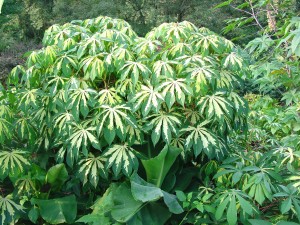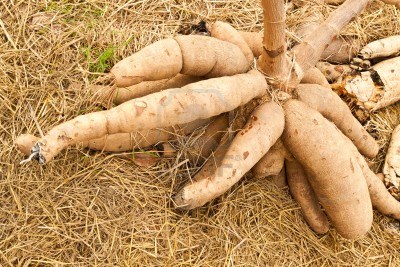
THE TAPIOCA PLANT.
IN the warmest parts of the earth, and mostly in Brazil, grows the plant from which tapioca is obtained. Its most common name is the Manioc Plant, though it bears several other names much resembling this. You will all, perhaps, be surprised when you learn that the juice of the plant is deadly poison to both man and beast, and you may wonder how we are able to eat it without injury. It is indeed wonderful that man should be able to convert a poisonous plant into an article of food, which is used all over the world.
But let us first notice the plant itself. It is a shrub, with very crooked branches, and grows to the height of six or eight feet. The accompanying picture shows a small branch bearing leaves, flowers, and fruit. The flowers are of different colors, and the fruit is composed of three cells, each containing a shining seed. Behind the branch shown in the picture, may be seen a cluster of roots.
These are the only parts of the plant, which furnish food. They always grow in clusters, and are from one to two feet long, often reaching the size of a man's thigh, and sometimes weighing thirty pounds.
These roots are stripped of their rinds, and ground into a pulp, or paste. This is put into sacks and submitted to a heavy pressure, for the purpose of removing the poisonous juice. The cakes of flour that remain are baked or dried on hot iron plates.
This process causes whatever juice remains to evaporate. The natives call this flour cassava, and the poorer classes make cassava bread their chief food. The flour can be kept for a number of years, if preserved from moisture, and is very nutritious, half a pound a day being enough for one person.
But the tapioca, which we eat, is taken from the juice itself! After it is pressed out of the flour, it is left to stand for a long time, during which a starchy substance settles at the bottom. The poisonous fluid being turned off, the substance that remains is thoroughly dried, and shipped to all parts of Europe and America, where it is called tapioca, or Brazilian arrow-root. So much of this is now used that the plant has been transported to other parts of the world, and is made an important article of commerce. It is less affected by the climate, soil, and ravaging animals than most other crops, and an acre of it is said to furnish support to as many persons as will six acres of wheat.
Some kinds of Manioc are not poisonous. The roots of these varieties are sweet to the taste, and are roasted in hot ashes and eaten with butter.
